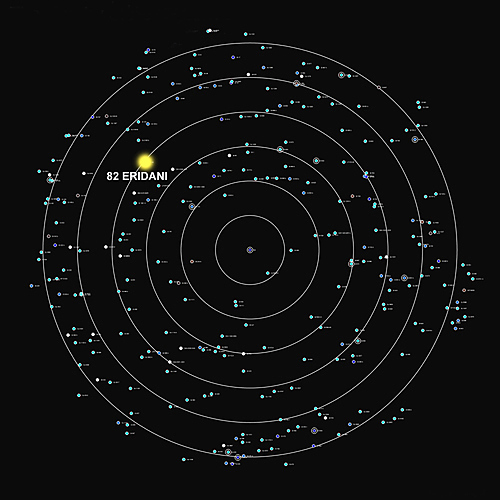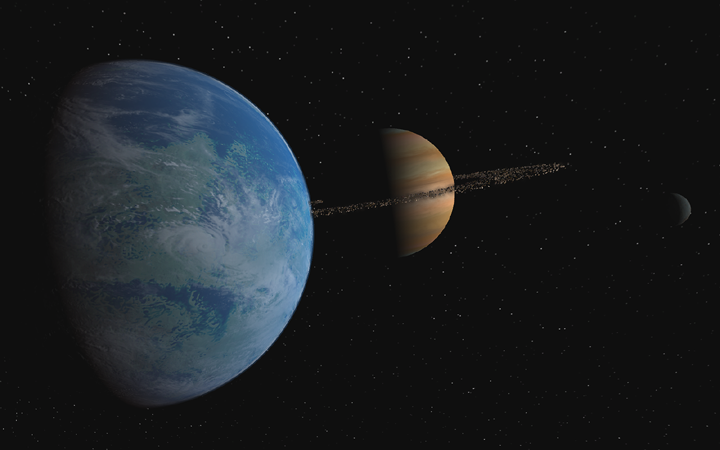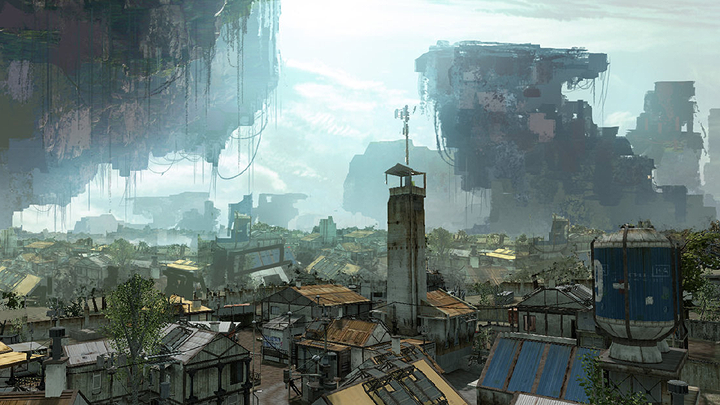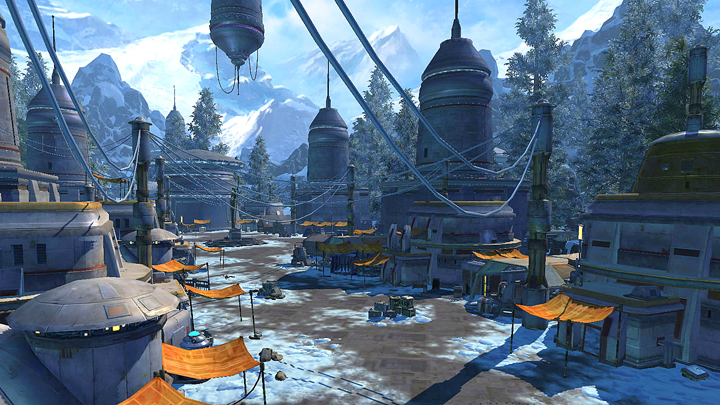
DISTANCE: 19.7 light years from Sol
NEIGHBORING SYSTEMS: Tau Ceti 11.9 lys Epsilon Eridani 12.4 lys Beta Hydri 15.2 lys
82 ERIDANI is a yellow-orange dwarf with a total of six planets in orbit. The first three are located so close to their host star that they are little more than burnt chunks of rock. The three outer planets; Niobe, Pelops, and Broteas, are all gas giants which have a combined total of 43 moons. Finally, there is a sparse field of asteroids and icy debris located at the far edge of the system. The star itself is somewhat deficient in heavy elements compared to Sol, however, valuable deposits of Ichorite are found exclusively in this region of space.
NIOBE is the fourth planet in this system and the smallest of the gas giants. Even so, it is still nearly twice the size of Saturn and is encircled by a dense ring of its own made up of small asteroids, dust, and rocky debris. Composed primarily of hydrogen, helium, and trace amounts of ammonia, this world is surrounded by a lethal halo of radioactive particles. Named after the Greek myth of Niobe, who was punished by the gods for being overly prideful of her fourteen children; this gas giant has a total of fourteen moons. Although Niobe is located at the distant edge of the system’s habitable zone, it has a massive internal heat source which has contributed to the development of life on three of its moons.

Draven is the closest of the life-bearing moons and receives much of its heat from the gas giant itself. Its surface is covered almost entirely by arid rocky deserts with only a few scattered seas and narrow tributaries. This moon’s orbit around Niobe lasts 12 days and lies just outside the main radiation belts except for when orbiting around the night side. At that time, it is shrouded in a shimmering aurora and receives a scourge of radiation. However, this world emits a highly active magnetic field which helps to filter much of it out and the sporadic animal life that has evolved here is relatively unaffected. Draven has a peak equatorial temperature on Niobe’s day side of 60 C and a low on the night side of 3 C.
Colonized by the Heimdall Foundry, this moon is home to a determined group of Human settlers who first established their community within an interconnecting maze of dry canyon beds. Dozens of shield emitters were erected directly above the settlement to protect them from any residual radiation as well as from the dust storms that frequently ravage the scarred landscape. Initially, the colonists here were completely dependent on the importation of water from the neighboring moons. Yet, in recent years, efforts to extract and purify local seawater has allowed them to become nearly self-sufficient. Mining on Draven, along with the nearby rings of Niobe, is the colony’s primary industry. According to the census of 2233, nearly 25,000 individuals reside in three separate communities; the largest of which is Canyon’s Gate. This township has become the epicenter for all trade and commerce on the desert moon.

Corvallis is the second of the life-bearing moons and orbits within the temperate zone between the gas giant and its host star. Water covers approximately 50 percent of its surface while the remaining landmasses consist of subtropical brush forests, grassy wetlands, and erratic mountain ranges. The moon’s orbit around the gas giant lasts 16 days with a peak equatorial temperature on Niobe’s day side of 45 C and a low on the night side of -5 C with only a minimal amount of radiation. As Corvallis passes behind the gas giant, most of its surface freezes. However, the wide variety of animal and plant life that exists here has evolved to adapt to these frequent changes in temperature.
Colonized by Frontier Industries, this moon was originally settled by many of the descendants of those who first colonized the Tau Ceti system. Like the generation that came before, their pioneering spirit has helped to create a rather progressive society that thrives on hard work and diversity. Their primary industries on Corvallis are centered on agriculture and freight distribution, but they are well-versed in spaceship construction as well. According to the census of 2233, nearly 60,000 individuals live in three separate townships located in the equatorial regions; the largest of which is Hope’s Landing. This community is currently the official seat of the presiding colonial government.

Lassiter’s Moon is the most distant of the three and receives much less heat from Niobe than the other two life-bearing moons. Liquid water covers only 25 percent of its surface, but the major landmasses are made up entirely of snow-covered mountains and subarctic tundra. This frigid world warms up only slightly as it passes between Niobe and its host star. It has an orbit around the gas giant which lasts 22 days with peak equatorial temperatures on the planet’s day side of around 3 C and a low on the night side of -30 C. Several resilient species of both mammals and birds have evolved on this world.
Colonized by the Mantell Corporation, this moon was first settled by an intrepid group of individuals who had previous experience in both manufacturing and hydrocarbon refinement. These skills have proven to be advantageous as they have established several mining operations in the outer asteroid belt as well as ore processing plants on Lassiter’s Moon. According to the census of 2233, almost 35,000 individuals live in three separate communities located in the equatorial regions; the largest of which is Boulder Pass. This mountainside township is a common port for both local trade and off-world business.

In the years that followed the end of the Zendathu-Human War, Earth and many of its colonies struggled to recover from their heavy losses. In spite of this, Frontier Industries, based in the Tau Ceti system, began to dispatch dozens of ships to explore the relatively unknown Western regions in an ongoing search for new resources. In 2195, the FIC-377 BRADBURY, was assigned to investigate the 82 Eridani system. The crew was surprised to find not just one, but three moons orbiting Niobe that supported indigenous life. They established a base of operations on Corvallis and spent the next three months surveying each moon. After discovering substantial quantities of Ichorite scattered throughout the rings of the gas giant, it was apparent that this system was a clear choice for permanent colonization.
Even so, the initial cost of such a large-scale venture was more than Frontier Industries was able to finance on its own. As a result, the private investors who backed this project turned to two smaller corporations in the Sol system that had remained loyal business associates for decades. Both the Mantell Corporation and the Heimdall Foundry were offered the opportunity to form a mutual partnership and establish their own individual colonies in this system. Frontier Industries continued to move forward with their initial settlement on Corvallis; while the other two companies began to relocate much of their operations to Lassiter’s Moon and Draven in an attempt to avoid Earth’s corporate bureaucracy. From the very beginning, all three colonies developed a symbiotic relationship with each other; leading to a variety of joint projects as well as the shipping of supplies from one moon to another depending on each community’s needs.
Nevertheless, their rapid success inevitably attracted the attention of the United Earth Conglomerate. As the UEC became fully aware of the overall economic value of this system, they initiated periodic inspections and security patrols; often using coercion and intimidation tactics to acquire the colonists’ cooperation. It wasn’t long before Earth’s government declared that any secondary settlements that were founded by existing colonies were subject to annexation. It was the hostile occupation of the Nioban moons by SolCorp marines which incited the colonists to gather up all their weapons and fight for their new homes. However, by the time reinforcements arrived, UEC troops were fully entrenched and a war with Earth seemed unavoidable.
Two months later, a meeting between representatives from Earth, Tau Ceti, and the 82 Eridani system was held at FENRIR Station regarding the dispute over colonial independence. The government of Earth was certainly not prepared for another prolonged conflict, yet deliberations continued for six arduous weeks before a definitive accord was finally agreed upon. This “Contract of Sovereignty” officially recognized the absolute autonomy of both the Tau Ceti and 82 Eridani colonies in exchange for the immediate relinquishment of all their remaining holdings in the Sol system. After SolCorp’s gradual evacuation from the three moons, the Cetians continued to support the colonists with their efforts on becoming completely self-sufficient.
The colonies of Draven, Corvallis, and Lassiter’s Moon have maintained an ongoing cooperative relationship with each other which has led to the expansion of interdependent business ventures, the exchange of cultures, and a greater diversity within their individual societies. They have established two orbital shipyards for constructing freighters as well as their own private fleet of light cruisers for defending themselves against raids by Gethum pirates. The Niobans, as the colonists now refer to themselves, remain fiercely independent, yet their long-standing association with the people of Tau Ceti has led to the formation of a democratic confederation of worlds called the Commonwealth Alliance. Caste disputes do occasionally occur between the three moons, but for the most part, the inhabitants of this system work together for the betterment of their entire society.